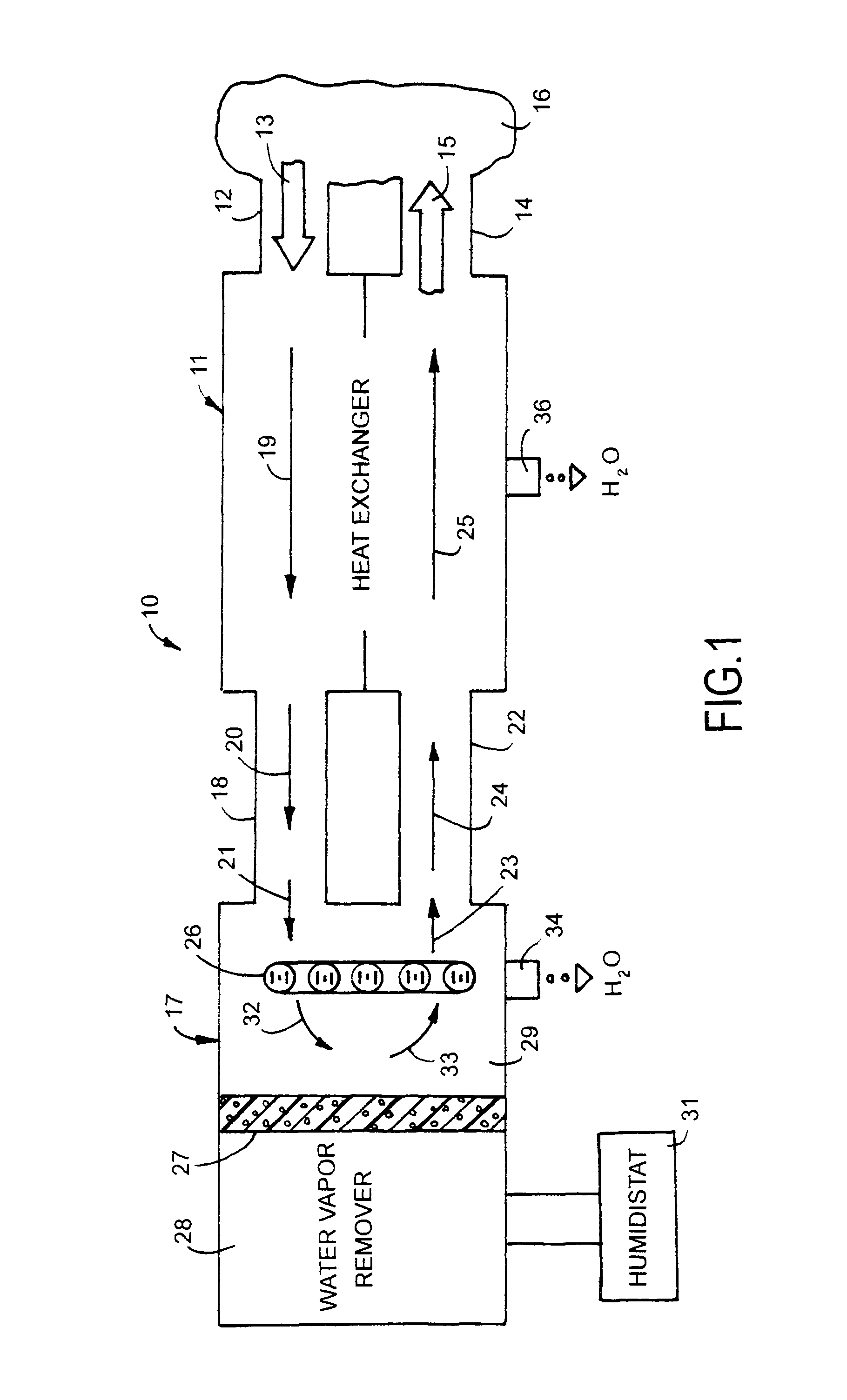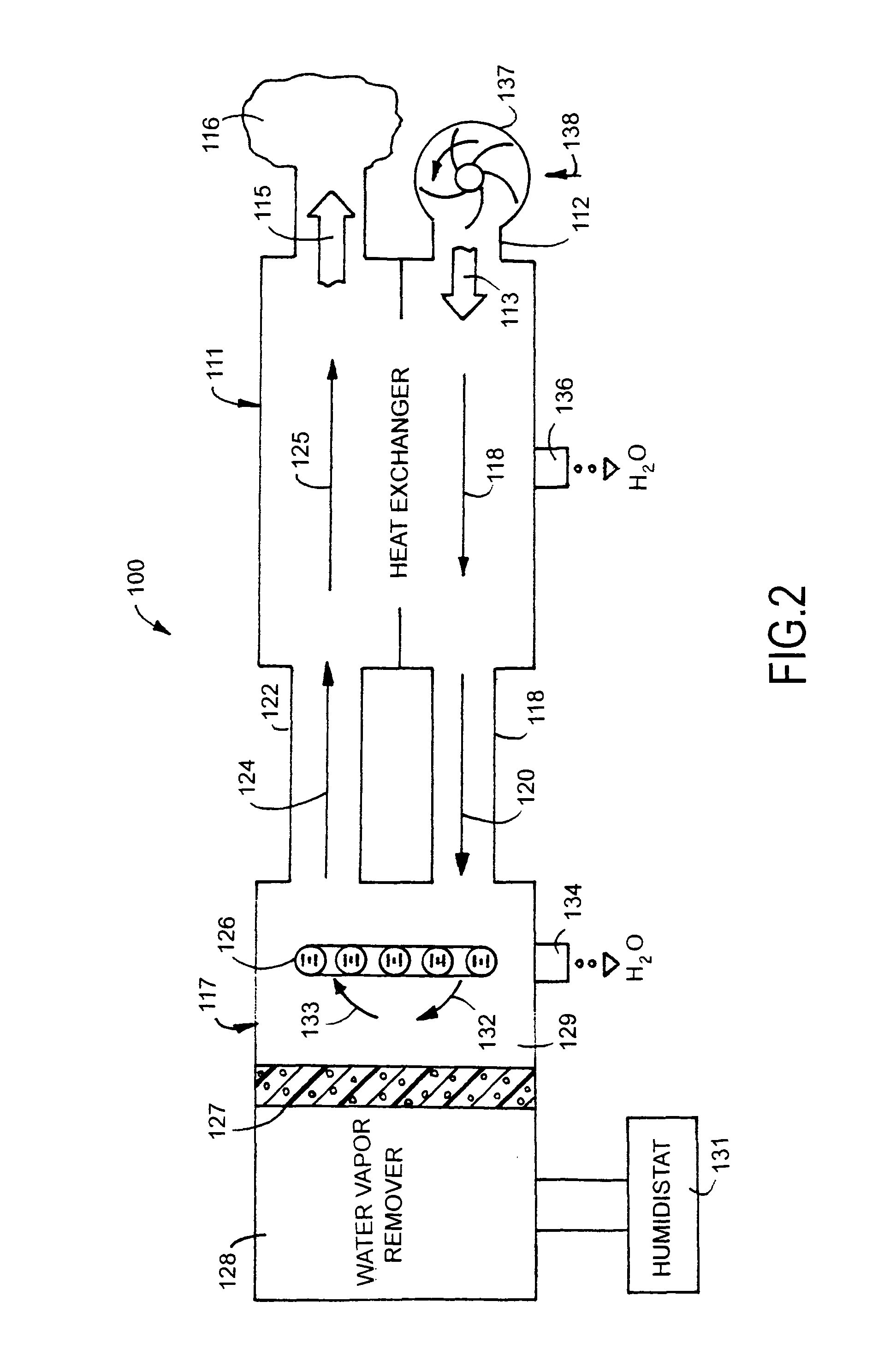Temperature and humidity air treatment system
a technology of air treatment system and temperature and humidity, which is applied in the direction of defrosting, heating type, heating apparatus, etc., can solve the problems of inconvenient control, inconvenient use, and inconvenient use of equipmen
- Summary
- Abstract
- Description
- Claims
- Application Information
AI Technical Summary
Benefits of technology
Problems solved by technology
Method used
Image
Examples
first embodiment
[0013]the temperature and humidity air treatment system 10, shown in FIG. 1, has a heat exchanger 11 combined with a water vapor remover 17 operable to control the temperature and humidity of air in an interior environment or enclosure 16, such as a residential, an office room or other enclosed environments. Dampers can be used to control the flow of air into a plurality of interior environments. Heat exchanger 11 is a device designed for the efficient transfer of heat from one fluid to another fluid over a solid surface. The transfer of heat is in the form of absorption from warm air to cooled air to reduce atmospheric air temperature and humidity in interior enclosure 16. The atmosphere is a mixture of air and water vapor. When the atmosphere is cooled under constant total pressure, the air pressure remains constant until a dew point temperature is reached at which condensation of water vapor begins and the air temperature decreases. Relative humidity RH is the ratio of the actual...
second embodiment
[0018]the humidity air treatment system 100, shown in FIG. 2, has a heat exchanger 111 combined with a water vapor remover 117 to regulate the air temperature and humidity of the air within an interior environment or enclosure 116, such as one or more rooms of a building. Dampers can be used to control the flow of air into more than one interior environment. The parts and functions of heat exchanger 11 and water vapor remover 17 shown in FIG. 1 are applicable to system 100 and are incorporated herein. The parts of system 100 that correspond to system 10 have the same reference number with the prefix 1.
[0019]Heat exchanger 111 has an air inlet duct 112 that allows air to flow, shown by arrow 113, into heat exchanger 111. A motor driven blower 137 pumps atmospheric air shown by arrow 138 into heat exchanger 111. The motor can be wired to humidistat 131 whereby humidistat located in interior enclosure 116 controls the operation of the motor that drives blower 137 in response to the rel...
third embodiment
[0020]the humidity air treatment system 200, shown in FIG. 3, has a heat exchanger 211 combined with a water vapor remover 217 to regulate the air temperature and humidity of the air within an interior environment or enclosure 216, such as one or more rooms of a building. The parts and functions of heat exchanger 11 and dehumidifier 17 shown in FIG. 1 are applicable to system 200 and as incorporated herein. The parts of system 200 that correspond to system 10 have the same reference numbers with the prefix 2. A motor driven blower 237 operates to discharge warm atmospheric air 238 into heat exchanger 211, shown by arrow 213. Blower 237 can be located to move air from enclosed environment 216 to heat exchanger 211. Blower 237 can be placed in different locations and structures relative to heat exchanger 211 and water vapor remover 217 to achieve effective air flow through heat exchanger 211 and water vapor remover 217. The PCMs or refrigerant in coils 226 cools the air flowing throug...
PUM
 Login to View More
Login to View More Abstract
Description
Claims
Application Information
 Login to View More
Login to View More - R&D
- Intellectual Property
- Life Sciences
- Materials
- Tech Scout
- Unparalleled Data Quality
- Higher Quality Content
- 60% Fewer Hallucinations
Browse by: Latest US Patents, China's latest patents, Technical Efficacy Thesaurus, Application Domain, Technology Topic, Popular Technical Reports.
© 2025 PatSnap. All rights reserved.Legal|Privacy policy|Modern Slavery Act Transparency Statement|Sitemap|About US| Contact US: help@patsnap.com



